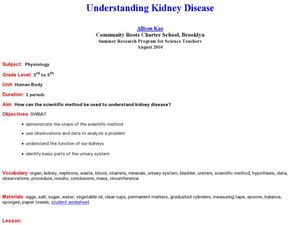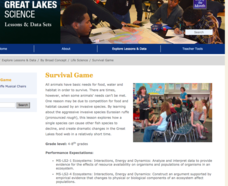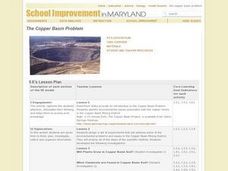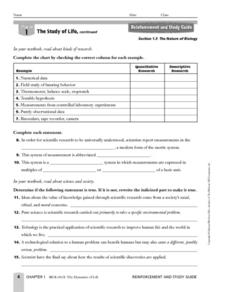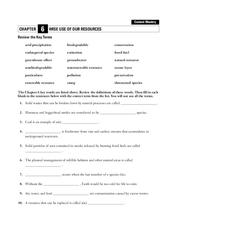Curated OER
Bioplastics
Students define bioplastics and identify its uses. In this bioplastics lesson, students compare and contrast styrofoam to starch peanuts after careful examination. Students understand what biodegradeable means.
Curated OER
Chain Reaction
Learners study animal behavior and how it changes to its environment. In this animal lesson students design and conduct experiments.
Curated OER
Testing Your Water
Students perform several water quality tests on groundwater from their area. They use test strips to determine the pH, hardness, alkalinity, nitrates, iron and chloride levels.
Curated OER
Medicine: Then and Now
Students read ancient Greek texts to explore ancient healing practices and compare them to modern-day medicine. They conduct research into modern first-aid practices, using a standard medical reference.
Curated OER
Speedy Succession
Fifth graders investigate how a pond ecosystem can change into a prairie or grassland ecosystem. They observe a small pond ecosystem in a two liter soda bottle, and examine and record changes over a two-week period of time on a worksheet.
Curated OER
Understanding Kidney Disease
Learners experiment to determine information about kidney function. In this kidney function lesson, students use the scientific method to experiment with eggs, water, salt, sugar, and vegetable oil to simulate kidney function. They...
Michigan Sea Grant
Survival Game
Musical chairs may be a classic game, but Ruffe Musical Chairs is a unique lesson on invasive species! Using the time-honored game, pupils role play the behaviors of the invasive fish called Eurasian ruffe. Learning about this aggressive...
Curated OER
Vitamin C and Protein Analysis
Students analyze various beverages to determine vitamin C content. Students research diseases resulting from vitamin C deficiencies and identify countries most affected.
Curated OER
Human Impact on the Life Cycle of Corals
Students study the life cycle of a coral reef. They then participate in a simulated village meeting in which they roleplay various characters who must review proposed legislation dealing with reef management.
Curated OER
The Copper Basin Problem
Students view a video about how human actions impact the environment. They design a set of experiments to address some of the problems and issues raised by the video.
Curated OER
Who Stole My Salad?
Eighth graders explain how protein is made in the cell. In this biology lesson, 8th graders translate RNA and DNA using an internet database. They determine the thief based on evidence collected.
Curated OER
Why Don't Whales Have Legs?
Students are given a variety of materials and are asked to design a heat loss experiment that results in a reasonable explanation of "Why don't whales have legs?" students work with the theory of natural selection.
Curated OER
"Chips" Off the Old Block?
Students study using analogies between common items or occurrences and science concepts. They use the analogy of cookie recipes to that of the DNA "recipes" for living things to help us explain more about mutations.
Curated OER
Ethical and Personal Decisions
High schoolers will learn about the current technology of genetic testing within the
framework of the biology curriculum through a lesson-produced PowerPoint presentation: "Genetic Testing" at: http://jbois.tripod.com/index.html.
Curated OER
The Siberian Arctic
Students, in groups, research the topics: habitats of northwestern Siberia, reindeer, oil and natural gas, and other threatened regions of the Arctic. They answer specific research questions based on their topic. They use online...
Curated OER
Chromosome Fusion
Students see how patterns can reveal events of the past, thereby merging elements of both experimental and historical science.
Curated OER
Stream Chemistry Monitoring
Students become familiar with real-world gathering of chemical data. The experience how the science is done: the nature of analysis, data collection, interpretation, and presentation. They study a nearby body of water for their experiment.
Curated OER
Mechanisms of Evolution
In this evolution worksheet, students will answer questions about population genetics and the theory of evolution of species. This worksheet has 15 true or false, 6 fill in the blank, and 4 short answer questions.
Curated OER
The Study of Life
In this scientific research worksheet, students will complete a chart by determining if the statements given are examples of quantitative research or descriptive research. Then students will fill in the blank of 8 statements about the...
Curated OER
Atoms and Their Interactions
In this atoms worksheet, students will review the characteristics of elements, atoms, and isotopes. Then students will compare the difference between ionic and covalent bonds. Finally, students will balance a chemical equation. This...
Curated OER
Wise Use of Our Resources
In this resource review worksheet, learners will review the definition of key vocabulary words and then fill in the blank with the correct term in 10 sentences.
Curated OER
Diversity of Arthropods
In this arthropods worksheet, students will review the characteristics of the different types of arthropods including spiders, ticks, crustaceans, millipedes, and insects. Students will also understand the difference between complete and...
Curated OER
Community Distribution
In this community worksheet, students read the definitions of primary and secondary succession and then choose a picture for each as an example. Students complete 1 true or false and 2 short answer questions.
Curated OER
Ecosystem Services - Water Purification
Students see that ecosystems provide services to people that are essential to life as we know it. Reporters (drops of water) could interview the trees and soil in the surrounding ecosystems for news stories on how they helped keep the...







